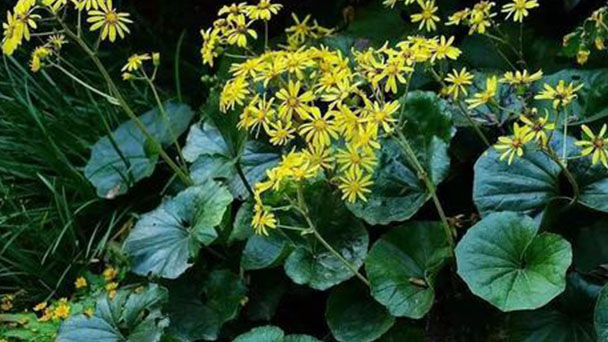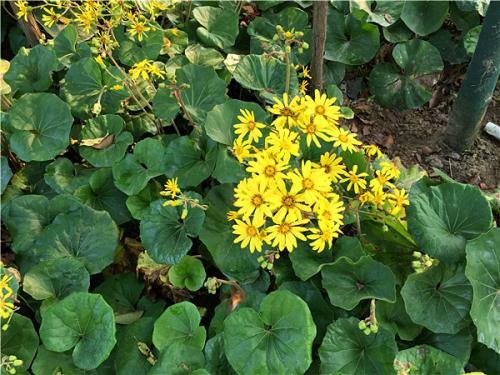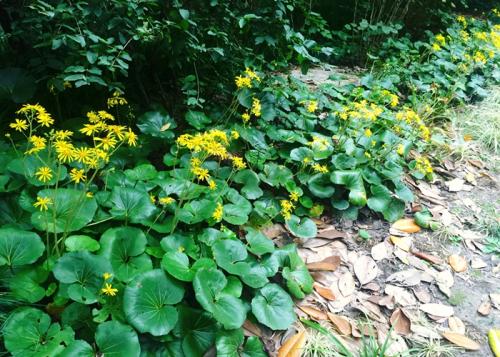Leopard Plant (Farfugium Japonicum) Profile: Info, Care & Growing Guide
Written by Maggie
Dec 13 2022

Leopard Plant, scientific name Fargium japonicum (L. F.) Kitam, is a perennial scaphoid herb.
Leopard Plant Picture

Leopard Plant Info
| Botanical Name | Farfugium japonicum |
| Common Names | Leopard Plant, ligularia, ragwort, goldenray, golden groundsel |
| Plant Type | Herbaceous perennial |
| Light | Part shade to full shade |
| Native Areas | China, Japan |
| Mature Size | 3 to 4 feet tall; 2- to 3-foot spread |
| Hardiness Zones | 3 to 8 (USDA) |
| Flower color | Yellow |
| Bloom Time | Mid to late summer |
Characteristics of Leopard Plant
Leopard Plant Rhizome
Leopard Plant is a perennial scape herb. The rhizome is stout, up to 1.2 cm in diameter. Scape is up to 70 cm, densely flaxen pubescent when young, more or less depilated later, base 5-6 mm in diameter, densely pubescent. Apex is rounded, entire or with denticulate or palmately lobed, base curved and lacking wide, both surfaces covered with gray-white pubescent when young, glabrous later; Petiole of leopard plant is 15-25 cm long, densely flaxen pubescent when young, glabrescent, base short sheaths, encrusted, densely hairy within sheaths; Lingual is oblong or spatulate oblong, anther tail at base; Corolla is white as long as corolla. Achene of Leopard Plant is cylindrical, up to 7 mm long, longitudinally ribbed, covered with rows of short hairs. (Also Read: 35 Recommended Daisy-Like Flowers for Your Garden In 2023)
Leopard Plant Leaves
Basal leaves of Leopard Plant are roseate, reniform, 9 -- 13 x 11 -- 22 cm long, apex rounded, entire or dentate or palmately lobed, base curved, one-third as long as leaf blade, grayish pubescent when young on both surfaces, glabrous later; Petiole is 15-25 cm long, densely flaxen pubescent when young, glabrescent, base short sheaths, encrusted, densely hairy within sheaths; Cine leaves of Leopard Plant have 1-3, bracts, oblong or linear-lanceolate, 1 -- 2 cm long.
Leopard Plant Flowers
Scape of Leopard Plant is up to 70 cm, densely yellowish pubescent when young, more or less glabrescent, very densely pubescent at base. Inflorescences head are radiate, 2-7, arranged in corymbiform pedicels 2-13 cm long, hairy; Involucral bracts are campanulate or broad gyro, 1.2-1.5 x 1.5-2.2 cm, mouth to 15 mm wide, involucral bracts 12-14, 2-tiered, oblong, apex acuminate, dorsal hairy, inner margin brownish broadly membranous. Leopard Plant has 8-12 ligulate flowers, yellow, ligulate oblong or spatulate oblong, 15-22 mm long, 3-4 mm wide, apex rounded or acute, tube 6 -- 9 mm long; Tubular flowers are the majority, 10-12 mm long, 6-9 mm long tube. Tubular flowers are numerous, 1-1.2 cm long, tube length ca. 6 mm; Anthers of Leopard Plant are caudate at base; Corolla is white as long as corolla. Achene is terete, up to 7 mm long, longitudinally ribbed, covered with rows of short hairs.
Leopard Plant Fruit
The Leopard Plant's fruit is cylindrical, up to 7 mm long, longitudinally ribbed and covered with rows of short hairs.
Leopard Plant Growth Conditions
Leopard Plants grow in forests, valleys and grasses at low altitudes. Leopard Plant likes a half shade and humid environment; Leopard Plant is cold-resistant, in the area of the south of the Yangtze River can overwinter on the ground; Leopard Plant is afraid of direct sunlight, has good adaptability to the soil, with fertile loose, good drainage black soil is appropriate.
In late autumn, when most of the flowers are gone, the leaves turn yellow and the branches are covered with fruit, the Leopard Plant, like its distant cousin, the chrysanthemum, is in full bloom.

How to Grow and Care for Leopard Plant
Leopard Plant Soil Care
Leopard Plants are suitable for growing in rich, loose, well-drained black soil. Cultivation can be garden soil, leaf rot soil and river sand equal mix, as a culture soil. It is best to change the soil once a year.
Leopard Plant Temperature Care
Leopard Plants like relatively warm temperature conditions and need to take certain measures to keep warm in winter. It is best to move it indoors and keep the indoor temperature above 5℃.
Leopard Plant Light Requirements
Leopard Plants like semi-overcast light conditions, can not be exposed to the sun for a long time.
Leopard Plant Watering
Leopard Plants prefer wet soil conditions but cannot grow long in wet soil.
Leopard Plant Fertilizer
If planted in rich, humus-heavy soil, leopard plants don't require any feeding. The best fertilizer is a thick layer of organic mulch applied in the spring.
Leopard Plants Propagation
Leopard Plants are often propagated by division. Turn over the pot and change the soil in spring. Shake off the soil after removing the pot. Divide the plant clusters into 3 ~ 4 parts and put them into the pot respectively. Leopard Plants can be cultivated in the garden, after planting management can be more extensive, winter on the ground died, the next spring will sprout leaves, appropriate shade in midsummer, control watering at the end of autumn, October into the room to keep warm, winter overwintering temperature is not less than 5℃. It is updated every 2 ~ 3 years.
Leopard Plant Distribution
Leopard Plant produced in Hubei, Hunan, Guangxi, Guangdong, Fujian, Taiwan in China.
Leopard Plants grow in forests, valleys and grasses at low altitudes. It is also cultivated in some botanical gardens and homes at home and abroad.
Leopard Plant is common in Japan (where type specimens are produced), wild or cultivated.
Leopard Plant Uses
Ornamental effect
In view of its natural characteristics, Leopard Plant will be planted in the roadside forest, and Ophiopogon, orchids, Panax notoginseng and other common to create a forest landscape like autumn flower landscape tourists do not miss it.
Medical use
The root of the Leopard Plant contains trichloroic acid (dimethacrylic acid), which is mainly used for cough, hemoptysis, hematochezia, irregular menstruation, bruisings and mastitis.
Leopard Plant Varieties
- Ligularia dentata 'Britt-Marie' is one of the more popular cultivars. It has large dark chocolate-colored leaves and blooms in mid to late summer. Growing 3 to 4 feet tall, it has better sun tolerance than most varieties.
- L. dentata 'Desdemona' has dark yellow flowers and purplish-red leaves. It grows 2 to 3 feet tall and has deep green leaves.
- Ligularia 'Osiris Café Noir' is a dwarf hybrid variety with leathery bronze leaves. It flowers in mid-to-late summer and grows about 20 inches tall.
- Ligularia 'Othello' has large, mohogany-colore leaves and has bright gold flowers. It grows 30 to 42 inches tall.
- Ligularia stenocephala 'The Rocket' is a very popular variety with deep green serrated foliage and long dark stems of bright yellow flowers. It is a large plant, growing 4 to 6 feet tall with a similar spread.

Latest Updated
- Benefits of Bugleweed - 7 Science-backed Health Benefits
- Bugleweed Dangers & Side Effects - Is It Poisonous?
- How to Plant Evergreen Trees - What You Should Know
- When to Plant Evergreens - Grow Guide for Evergreen Trees
- 12 Wonderful Evergreen Shrubs for Your Garden
- 12 Popular Evergreen Plants with Pictures for Beginners
- When And How To Prune A Lilac Bush Like a Pro
- How to Grow & Care for Lilac Vine (Hardenbergia Violacea)
- Japanese Lilac Tree (Syringa Reticulata) Care & Propagation Guide
- Shumard Oak Pros and Cons - What to Know
Popular Articles
- Winter maintenance of Antirrhinum Majus
- How to Grow Terminalia Mantaly Tree
- How to Grow and Care for Crossostephium Chinense
- How to grow Antirrhinum Majus in spring
- Peristeria Elata (Dove Orchid) Profile: Info & Care Guide
- Underwatered Snake Plant (Sansevieria Trifasciata) - Signs And How To Fix
- How to Care for Brazilian Jasmine Plant (Mandevilla Sanderi)
- How to Grow & Care for Graptopetalum Purple Delight in Summer
- Rosa Chinensis (China Rose): Plant Growing & Care Tips
- How to Care for Baby Sun Rose (Aptenia Cordifolia)